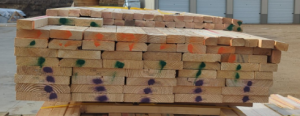Why isn’t a 2×4 truly 2” x 4”?
When Hansen Pole Buildings first began in 2002, owner J.A. Hansen did all of the drafting. As a lifetime Registered Nurse, Judy had the attention to detail it took to be an excellent drafter. In her “nursing world” everything was measured in exact numbers. If a patient needed 10 milligrams of a drug, they were administered exactly 10 milligrams. No more, no less, and right on schedule. You didn’t give the patient between 5 and 20 milligrams, somewhere between 8AM and noon!
This is where the challenge came in for Judy learning to draft…a 2 x 4 did not measure 2 inches by 4 inches! Not only that, once I patiently explained framing lumber and sizes, a 2×4 was not even held to an exact 1-1/2” by 3-1/2”, but had an “acceptable range” for size, I was afraid she’d walk right out the door and never come back!
Back in the olden days of cutting trees into framing lumber, a 2×4 did actually measure more or less two inches by four inches.

Eventually evolution created high production building and high production sawmills. High production builders demanded smooth surfaced lumber to work with, rather than the rough sawn lumber primitive mills had been cranking out. About the same time, dried lumber became popular for its dimensional stability and resistance to mold.
Running the formerly rough cut 2×4 through a planer (to create smooth surfaces) and the drying process created a finished piece of lumber which measured 1-5/8” x 3-5/8”.
In the late 1970’s today’s standard sized 1-1/2” x 3-1/2” dry 2×4 was created. Besides ½ inch being easier to measure than 5/8 inch, we can only assume some brilliant bean counter in a sawmill office determined this would allow the recovery of one extra 2×4 board out of every log!
There are those naysayers who would attribute this “smaller” piece of framing lumber to less longevity in modern structures. However, all engineering calculations are based upon the actual dry size of the material being utilized. Yes, the sizes are somewhat confusing, but they do work.
To receive more pole building tips and advice subscribe to the pole barn guru blog!







I think the nominal size of lumber should be the actual size. Surely this is technically possible.
The trick here I would think is that “two by four” is a lot easier to spit out than “one and a half by three and a half”. On the technical side, it probably isn’t a problem for engineers and drafters to type things up on Bills of Materials and prints as such, but builders are not going to want to spend the effort saying, “hand me that “one and a half by three and a half”, when they could get by with fewer words, especially on a noisy job site with lots of nail guns going and stuff like that. It is probably way simpler to just explain to everyone who needs to know that the sizes are smaller, like how they do.
I believe the “bean counter” explanation. All the rhetoric about planing, drying, mold, etc. is industry double-talk. 1.5 x 3.5 wood only “works” because the entire building industry has accepted it, but a child can tell you that a 1.5 x 3.5 is not as strong as a 2×4. Call it what it is, and stop making excuses.
No excuses, it just is what it is, so we all get to work with it. You might find this article to be of interest, as The Home Depot and Menards have just been sued for misleading consumers in regards to lumber sizing: https://www.usatoday.com/videos/money/business/2017/06/22/home-depot-menards-sued-misleading-lumber-size-description/103098070/
As an IT geek who has NEVER seen a hard drive’s true formatted capacity equal the size it’s sold at (most “1 TB” drives will have about 930 GB at best), I just assumed that lumber and IT marketing people had the same ideas. 😉
I was always told it was to account for 1/2 inch plywood, drywall, ect.
Am guessing that is not the actual reasoning, but interesting theory.
Adding insult to injury, the value of the lumber is calculated on the “nominal” volume of the lumber in “board feet”. So in the case of a 1.5″ x 3.5″ two by four, the numbers used in the calculation are 2″ and 4″ rather than the actual sizes.
To avoid even more confusion, I won’t get into the details of the full calculation for board feet, but it’s an arcane calculation from way back in the mists of time.
Jon.